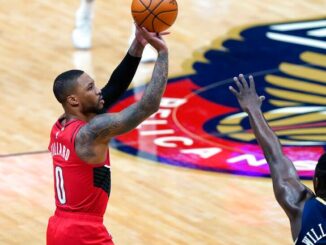
For the children of those special athletes who craft a superstar legacy, it will always be extra hard to live up to the standard and expectations of their predecessors. For someone like Bronny James, who has the unenviable task of being the first generational follow-up act to possibly be the greatest basketball player of all time, that standard is set almost impossibly high. Even if the oldest James son went on to have a decade of successful years in the NBA, a handful of All-Star appearances, and a championship, his resume would still need a couple careers worth of accolades to stack up to his father’s. That type of expectation is unfair to anyone, especially a kid, but that hasn’t stopped sports media from pointing a massive spotlight on Bronny basically since he started playing competitive basketball.
That type of attention only increased the closer he got to college, culminating in his commitment to the University of Southern California in May last year. He entered USC as a top-20 recruit in the country, and it was the presiding assumption that he would be a one-and-done and declare for the NBA after his first year. However, over the past year, unforeseen circumstances have arisen that throw that narrative into immediate question. First and foremost, James suffered a shocking cardiac arrest at a July workout last summer and had to suspend on-court activities for almost four months. He missed the first eight games of USC’s 2024 season before debuting on December 10th and playing for the rest of the season.
While this medical situation understandably dampened the hype for his debut, fervor had built back up by the time he made it to the court, with fans and critics alike eagerly waiting to see his true impact. However, as the season progressed, it became apparent that impact would be far more minor than most could have initially predicted, even with previously mentioned setbacks. James came off the bench for all but 6 of the 25 games he appeared in, averaging a paltry 4.8 PTS, 2.8 RBS, and 2.1 ASTS on 36/48/67 shooting splits (stats from Sports Reference). While there were individual highlights to pinpoint and flashes of both his athletic ability and promise as a lead guard, what he mostly showed was a need for significantly more development and time to grow those skills. On top of that, USC finished 15-18 overall, well short of the NCAA tournament and a disappointing result for a talent and resource-laden program.
As of April 2024, James has both officially entered the NCAA transfer portal and declared for the upcoming NBA draft, giving him two clear paths forward. There will undoubtedly be countless big programs comparable to USC that are willing to give him a significant NIL payout and invest in him as one of their next stars. In a collegiate environment, he could enjoy less immediate pressure and take his development slower and at a (probably) healthier pace. It would also be an opportunity to raise his draft stock and enter the NBA later as both a more prepared player and a higher draft pick.
His other option, of course, is to eschew further college play, attempt to get drafted this year, and hope that in a professional environment, growth will also be able to occur. A factor in all this is his father and how long LeBron wants to remain in the NBA. The older James has long stated and reiterated that he wants to play at least one season on the same team as his son, and Bronny immediately being drafted would speed that process up considerably. It also further incentivizes any team that drafts Bronny, as they will likely receive LeBron for that upcoming season. Even though he will be 40 at the end of this year, LeBron remains an All-Star presence, and adding him to one’s roster would mean an increased competitive ceiling as well as becoming a marketing monster able to advertise a once-in-a-lifetime father-son pairing.
When determining whether the Portland Trail Blazers should consider such a draft move, multiple facets exist. Most importantly, is how to evaluate the risk of spending a draft pick on a player with such mysterious potential as Bronny, with the obvious other side being the benefit of having LeBron join him and catapult your team to at least monetary, if not basketball, heights. Considering LeBron’s age, the possibility of him playing a season and immediately retiring is relatively high. If that single season isn’t entirely successful and Bronny doesn’t pan out in the next few years, the negative backlash could be massive. Especially considering that Portland is a small market team and needs to play their few draft cards exactly right to grow the kind of star talent, the team is rarely, if ever, able to attract in free agency.
Currently, the Blazers hold the fifth-worst record in the NBA with a week left to play, and if that were to remain at the end of the season, they would have the fourth-best odds at the #1 pick. They also own the rights to Golden State’s first-round pick this year (projected in the late lottery) as well as their own second-round pick, which will be in a good spot due to their record. The Blazers’ number one priority right now should be amassing talent to supplement their young core of Anfernee Simons, Deandre Ayton, Shaeden Sharpe, and Scoot Henderson, and they need to make sure they hit on all these upcoming picks. Therefore, the only pick they should consider using on Bronny would be that second-rounder. While experts say it may not be the strongest draft near the top, the Blazers’ potential two lottery picks must be spent on more established talent. If Bronny ultimately decides to declare there is nothing wrong with the Portland front office taking time to consider drafting him later, that should be the limit of the attention granted to him, at least for this year.



